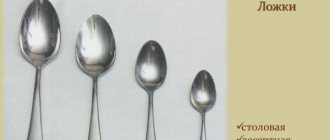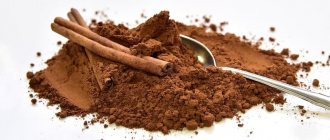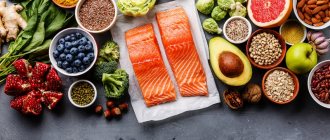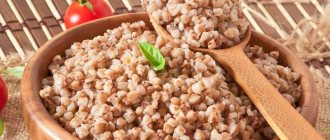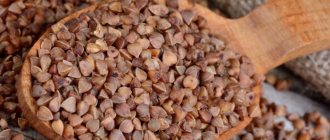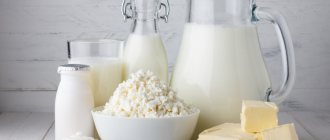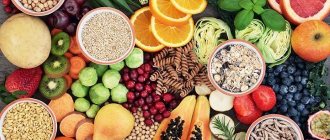- home
- Directory
- units of measurement
- Mass and weight
- How many grams are in a teaspoon, tablespoon and glass?
- How many grams of spices can a spoon and glass hold?
- How to measure correctly?
- The importance of the correct dosage of spices in canning
- How many grams are in a glass?
The dosage of bulk and solid products is indicated in grams or measured with spoons or glasses.
It is believed that a real housewife can measure the dosage of food “by eye”, but not everyone can do this and it is not worth the risk, as you could ruin the dish.
How can you measure the weight of food?
- scales
- steelyard
- measuring cup
- measuring spoon (jug) with electronic scales
- teaspoon
- tablespoon
- faceted glass
- thin-walled glass
- a special set of measuring spoons (you can even buy them at Fix Price)
Show slideshow
Also, in connection with the above problem of “different dishes”, at the beginning I would like to give general rules for measuring products.Chemical composition of almonds
Almond kernels are one of the richest sources of nutrients and phytochemicals that are essential for maintaining human health.
Almonds are a source of vitamin E (25 mg per 100 g of nuts). 100 g of nut kernels contain an impressive amount of minerals:
- manganese (Mn) - 2.285 mg;
- potassium (K) -733 mg;
- magnesium (Mg) - 270 mg;
- calcium (Ca)—269 mg;
- iron (Fe) - 3.71 mg;
- zinc (Zn) - 3.12 mg;
- selenium (Se)—2.5 mcg.
Almonds are a source of powerful antioxidants, most of which are concentrated in the outer brown layer of the nut.
Nut kernels contain a lot of B vitamins . Namely:
- riboflavin - necessary for the functioning of the nervous and cardiac systems, helping to reduce eye fatigue, etc.;
- niacin (vitamin B3) - responsible for lowering cholesterol;
- thiamine (vitamin B1) - important for the growth and development of children;
- pantothenic acid (B5) - ensures the body's resistance to stress;
- vitamin (B6) - performs the function of protecting the body.
Rules for using home weights
- Fill the glasses with liquid to the very brim
- Typically, in cooking, two types of glasses are used for measuring: faceted (200 ml) and thin-walled (250 ml)
- Apply viscous and thick mixtures, for example, honey, jam, with a spoon, so that there are no free cavities left. For the same reason, we spoon the flour rather than pour it from a bag, otherwise cavities will form in the glass
- One more nuance about flour - do not weigh it after sifting, it will be much lighter
- Pour bulk products heaped
- Watch the quality of the products, raw salt and sugar will be much heavier, but expired sour cream is lighter
Weight of a glass of kefir and sour cream
This fermented milk product is highly valued in cooking: it can become the basis for tasty and healthy sauces, gravy and dough. Also, kefir will be a complete and healthy afternoon snack or dinner for those who strive for an ideal figure. In any case, a glass of kefir, how much it will be in grams, is information that will be useful to different groups of people. Due to its high density, kefir, like milk and water, will take up the entire container. This means that a 200 ml faceted and plastic cup will contain 200 grams of kefir, and a 250 ml cup will contain 250 grams.
A glass of sour cream, how many grams does it weigh? The answer to this question is also of interest to culinary enthusiasts. This product is used to prepare delicious pastries and other desserts, aromatic sauces and gravy. There is 210 g of sour cream in a faceted glass, and 250 g in a thin-walled tea glass.
How many grams in a teaspoon
| 1 teaspoon | Product type | Spoon without slide | Heaped spoon |
| 1 teaspoon | flour | 9 grams | 12 grams |
| 1 teaspoon | sugar | 5 grams | 8 grams |
| 1 teaspoon | powdered sugar | 10 grams | 13 grams |
| 1 teaspoon | fine salt | 7 grams | 10 grams |
| 1 teaspoon | soda | 7 grams | 10 grams |
| 1 teaspoon | rice | 5 grams | 8 grams |
| 1 teaspoon | coffee | 4 grams | 7 grams |
| 1 teaspoon | honey | 10 grams | 12 grams |
| 1 teaspoon | dry yeast) | 2.5 grams | 3 grams |
| 1 teaspoon | cocoa | 6 grams | 9 grams |
| 1 teaspoon | cinnamon | 5 grams | 8 grams |
| 1 teaspoon | gelatin (granules) | 5 grams | 8 grams |
| 1 teaspoon | citric acid | 5 grams | 8 grams |
| 1 teaspoon | water | 5 grams | |
| 1 teaspoon | vinegar | 5 grams | |
| 1 teaspoon | milk | 5 grams | |
| 1 teaspoon | vegetable oil | 5 grams | |
Average weight of one grain
Like all fruits, nuts or grains in nature, peanut kernels vary in size. First of all, the dimensions are determined by which of the 5 main varieties we are talking about. Therefore, we can only talk about the range in which most of them fall. The weight of 1 piece after cleaning ranges from 0.3 g to 0.5 g.
The largest variety is considered to be “Virginia”. It is most often eaten whole. Valencia and Spanish have the smallest kernels. They are used mainly for making pasta. Moreover, in each of the 5 main varieties there are subspecies, which also differ in caliber and how much one peanut weighs.
How many grams in a glass
Nowadays, there is a huge variety of glasses, but in cooking, as a rule, a faceted glass is taken as the basis, so the grams of the faceted glass will be indicated in the table below
| 1 faceted glass | Product type | Grams |
| 1 glass | water | 200 grams |
| 1 glass | vegetable oil | 180 grams |
| 1 glass | ghee | 190 grams |
| 1 glass | cream | 210 grams |
| 1 glass | flour | 130 grams |
| 1 glass | Sahara | 190 grams |
| 1 glass | salt | 200 grams |
| 1 glass | rice | 190 grams |
| 1 glass | honey | 280 grams |
How much does the average daily weight weigh?
In order not to worry about the extra pounds gained, nuts should be consumed in moderation, as this product is high in calories. Nutritionists advise limiting intake to 20-25 pieces per day. A handful of ripe nuts is enough to stay slim. If a person losing weight is engaged in mental work or sports, then he is allowed to eat the maximum amount of almonds (25 pieces) every day.
Taking into account the fact that it is recommended to consume 20-25 whole kernels per day, we can calculate that the average daily dose of almonds for an adult is 30 g. This norm is 182 kcal and contains:
- 6 g proteins;
- 5 g carbohydrates;
- 17 g fat;
- 4 g fiber;
- 1.5 g sugar.
Regular consumption of almond fruit reduces the levels of two biomarkers of oxidative processes. Taking 30 grams daily reduces the concentration of bad cholesterol (LDL) in the blood. Inhibits oxidative processes in the body's cells, which provoke aging. Acts as a fat burner.
Many are skeptical, citing the large number of calories in the product. But the fact is that some of the fats are excreted unchanged, i.e. does not split and is not absorbed. Therefore, the weight loss effect of taking almonds is very noticeable.
It is better to divide the daily dose into 2-3 doses. Before this, the kernels must be peeled and eaten whole, without any additives.
Measuring tables for various products
Measuring table of bulk products
| Product name | Faceted glass - 200 ml (g) | Thin glass - 250 ml (g) | Table spoon | teaspoon |
| FLOUR AND GREATS | ||||
| Wheat flour | 130 | 160 | 20 | 10 |
| Semolina | 150 | 200 | 16 | 4 |
| Buckwheat | 170 | 200 | 20 | 5 |
| Pearl barley | 200 | 230 | 23 | 6 |
| Millet groats | 190 | 225 | 20 | 5 |
| Jan cereal | 190 | 225 | 20 | 5 |
| Oatmeal | 130 | 170 | 18 | 5 |
| Corn grits | 145 | 180 | 20 | 6 |
| Oatmeal (Hercules) | 70 | 90 | 12 | 3 |
| OTHER BULK PRODUCTS | ||||
| Peas | 190 | 230 | 20 | 5 |
| Gelatin | ———— | ———— | 15 | 5 |
| Starch | 130 | 160 | 30 | 10 |
| Coffee | ———— | ———— | 20 | 10 |
| Cocoa | ———— | ———— | 15 | 5 |
| Lemon acid | 250 | 300 | 30 | 10 |
| Poppy | 125 | 155 | 15 | 5 |
| Baking powder | ———— | ———— | 15 | 5 |
| Rice | 180 | 240 | 30 | 10 |
| Powdered sugar | 140 | 190 | 24 | 8 |
| Fine salt | 320 | 400 | 30 | 10 |
| Granulated sugar (sugar) | 160 | 200 | 25 | 7 |
| Soda | 160 | 200 | 28 | 12 |
| Beans | 190 | 230 | 20 | ———— |
| Lentils | 190 | 210 | ———— | ———— |
Measuring table for liquid and paste products
| Product name | Faceted glass - 200 ml | Thin glass - 250 ml | Table spoon | teaspoon |
| Jam | 270 | 325 | 35 | 15 |
| Water | 200 | 250 | 15 | 5 |
| Yogurt | 250 | ———— | 20 | 10 |
| Kefir, fermented baked milk | 250 | ———— | 18 | 6 |
| Mayonnaise | 260 | ———— | 25 | 8 |
| Honey | ———— | ———— | 21 | 17 |
| Milk | 200 | 250 | 15 | 5 |
| Liquor | ———— | ———- | 20 | 7 |
| Vegetable oil | ———— | ———— | 17 | 5 |
| Cream | 200 | 250 | 15 | 5 |
| Sour cream | 210 | 260 | 25 | 10 |
| Condensed milk | ———— | ———— | 30 | 12 |
| Creamy melted butter | ———— | ———— | 25 | 8 |
| Soy sauce | 230 | ———— | 21 | 7 |
| Tomato paste | ———— | ———— | 30 | 10 |
| Table vinegar | 200 | 250 | 15 | 5 |
How many milliliters of liquid are in a spoon or glass?
- How many ml in a tablespoon? 15 ml in a tablespoon = 3 teaspoons
- How many ml in a teaspoon? 5 ml in a teaspoon
- How many ml are in a dessert spoon? In a dessert spoon 10 ml = 2 teaspoons
- How many ml are in a faceted glass? In a faceted glass 200 ml
- How many ml are in a tea (thin) glass? 250 ml in a tea glass
Measuring table of berries, fruits, dried fruits
| Product name | Faceted glass - 200 ml | Thin glass - 250 ml | Table spoon | teaspoon |
| Peanut | 140 | 175 | 25 | 8 |
| Cowberry | 110 | 140 | 20 | ———— |
| Cherry | 130 | 165 | ———— | ———— |
| Walnut | 130 | 165 | 30 | 10 |
| Blueberry | 160 | 200 | 25 | ———- |
| Blackberry | 150 | 190 | 30 | ———- |
| Raisin | 155 | 190 | 25 | 7 |
| Pine nut | 110 | 140 | 10 | 4 |
| Strawberry | 120 | 150 | 25 | ———- |
| Cranberry | 115 | 145 | 25 | ———- |
| Gooseberry | 165 | 210 | 35 | ———— |
| Raspberries | 145 | 180 | 30 | ———- |
| Almond | 130 | 160 | 30 | 10 |
| Sunflower seeds | 135 | 170 | 25 | 8 |
| Black currant | 125 | 155 | 25 | 8 |
| Red currants | 140 | 175 | 30 | 10 |
| Pumpkin seeds | 95 | 125 | 20 | 7 |
| Hazelnut | 130 | 160 | 30 | 10 |
| Fresh blueberries | 160 | 200 | 35 | ——— |
| Dried blueberries | 110 | 130 | 15 | ———- |
| Dried rose hips | ———- | ——— | 20 | 7 |
Measuring weight table for vegetables and other products
| Product name | Weight of 1 product in grams |
| Apricot | 40 |
| Orange | 140 |
| Eggplant | 200 |
| Pear | 135 |
| Strawberries | 8 |
| White cabbage | from 1500 |
| Potatoes (medium size) | 100 |
| Lemon | 50-70 |
| Onion (medium size) | 75 |
| Carrots (medium) | 75 |
| Cucumber (medium) | 100 |
| Peach | 85 |
| Tomato | 75 |
| Radish | 20 |
| Radish | 170 |
| Turnip | 85 |
| Plum | 30 |
| Apple | 90 |
| Egg C0 | 55-60 |
| Egg C1 | 50-55 |
| Egg C2 | 40-45 |
| Egg yolk | 20 |
| Egg white | 30 |
What determines the weight of the bulk component?
Information on the Internet is very diverse.
According to some sources, the dining room holds 20-25 grams, counting flush with the edges and with a slide, according to others - 10-15 grams. How to determine who is right? It turns out that there are 3 ways to measure the desired weight:
- Use a spoon to scoop the powdered mixture from a large container, shaking the cutlery slightly a couple of times. The result is 25 g of premium flour. If you don’t shake, but leave a heap - 30-35 g, level the level with the edges - 20 g.
- Pour in the bulk substance - 20, 25, 15 grams, respectively.
- Pour the sifted ingredient into the cutlery - the weight decreases by another 5 g, respectively.
The weight of flour powder depends on the type of grinding. The smaller the fraction of particles (highest grade), the heavier they are.
The amount of substance in a tablespoon is also affected by:
- moisture or flowability of the flour product;
- type of ground components (potato, corn, oatmeal, rye and other initial products);
- the capacity of the cutlery itself (a device 7 cm long and 4 cm wide is considered standard).
Control measurements are carried out at an ambient temperature of 0°C, atmospheric pressure of 760 mm Hg. Art. It is simply unrealistic to achieve such conditions when cooking at home, so the term “tablespoon of flour” means the amount of product that is freely poured and held without crumbling. That means with a small slide.
Foreign weights
My husband and I often like to look at foreign sites about food and take some recipes into service, but there is a small catch - they have different weight measures. For example, in addition to quarts, pints and ounces, they do not measure in glasses; instead they use cups, which, you see, is not usual for us and cannot be compared in any way with the volume of our glass. Therefore, we present foreign weight measures.
American volume measures
| 1 cup | 250 ml |
| 1/4 cup | 60 ml |
| 1/2 cup | 125 l |
| 2/3 cup | 170 ml |
| 3/4 cup | 190 ml |
| 1 tsp (1 tsp) | 5 ml |
| 1 tbsp. (1 tbsp) | 15 ml |
| 1 pint | 470 ml |
| 1 quart (1 qt, qwart) | 950 ml |
| 1 fl. oz. (1 fl. oz.) | 30 ml |
English volume measures
| 1 cup | 280 ml |
| 1 tsp (1 tsp) | 6 ml |
| 1 tbsp. (1 tbsp) | 17 ml |
| 1 pint | 570 ml |
| 1 quart (1 qt, qwart) | 1100 ml |
Weights
| 1 ounce (1 ounce) | 28.3 g |
| 1 pound | 450 g |
Measure with a spoon
A tablespoon is a universal tool with which you can measure almost any amount of flour product. In this case, you should try to pour equal portions. The event is simple if a small number of measured doses is required. But to measure out more than 10 spoons, a little difficulty arises. The solution is to remember how many spoons a glass, cup, or jar contains. Then cooking according to a recipe will no longer be burdensome with endless measurements.
To prepare dishes with added flour, it is advisable to use containers with a known volume. In this case, you need to remember the table for the correspondence of the amount of ml to the weight of flour in grams:
- a 100 ml container holds 65 g of flour product (3 tablespoons and a small pinch);
- 150 ml contains about 100 g (5 tablespoons);
- A 180 ml container holds 115 g of flour (almost 6 tablespoons);
- 200 ml – 130 g (6.5 tablespoons);
- 250 ml – 160 g = 8 tbsp. spoon;
- 300 ml of flour weighs 200 g (10 full tablespoons).
Knowing the ratio of volume and weight of products, it is always possible to calculate how many tablespoons of flour are needed to prepare homemade delicacies.
Calorie content of almonds
Almonds are a nutritious food (579 kcal per 100 g of product) with a high fat content that can be used both in cooking and eaten salted, raw or fried.
The carbohydrate content in 100 g of purified product is 21.55 g, protein - 21.15 g, fat - 49.93 g. Cholesterol in nuts is 0 mg, fiber - 12.50 g.
Since almonds are high in calories, you need to exercise portion control when consuming them.
